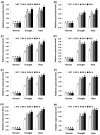Overexpression of Rice Rab7 Gene Improves Drought and Heat Tolerance and Increases Grain Yield in Rice (Oryza sativa L.)
- PMID: 30658457
- PMCID: PMC6357162
- DOI: 10.3390/genes10010056
Overexpression of Rice Rab7 Gene Improves Drought and Heat Tolerance and Increases Grain Yield in Rice (Oryza sativa L.)
Abstract
Rab family proteins play a crucial role in plant developmental processes and tolerance to environmental stresses. The current study investigated whether rice Rab7 (OsRab7) overexpression could improve rice tolerance to drought and heat stress conditions. The OsRab7 gene was cloned and transformed into rice plants. The survival rate, relative water content, chlorophyll content, gas-exchange characteristics, soluble protein content, soluble sugar content, proline content, and activities of antioxidant enzymes (CAT, SOD, APX, POD) of the transgenic rice lines were significantly higher than that of the wild-type. In contrast, the levels of hydrogen peroxide, electrolyte leakage, and malondialdehyde of the transgenic lines were significantly reduced when compared to wild-type. Furthermore, the expression of four genes encoding reactive oxygen species (ROS)-scavenging enzymes (OsCATA, OsCATB, OsAPX2, OsSOD-Cu/Zn) and eight genes conferring abiotic stress tolerance (OsLEA3, OsRD29A, OsSNAC1, OsSNAC2, OsDREB2A, OsDREB2B, OsRAB16A, OsRAB16C) was significantly up-regulated in the transformed rice lines as compared to their expression in wild-type. OsRab7 overexpression also increased grain yield in rice. Taken together, the current study indicates that the OsRab7 gene improves grain yield and enhances drought and heat tolerance in transgenic rice by modulating osmolytes, antioxidants and abiotic stress-responsive genes expression. Therefore, OsRab7 gene could be exploited as a promising candidate for improving rice grain yield and stress tolerance.
Keywords: OsRab7; antioxidants; drought and heat stress; gene expression; transgenic rice.
Conflict of interest statement
The authors declare no conflict of interest.
Figures







References
-
- Zang X., Geng X., He K., Wang F., Tian X., Xin M., Yao Y., Hu Z., Ni Z., Sun Q., et al. Overexpression of the Wheat (Triticum aestivum L.) TaPEPKR2 gene enhances heat and dehydration tolerance in both wheat and Arabidopsis. Front. Plant Sci. 2018;9:1710. doi: 10.3389/fpls.2018.01710. - DOI - PMC - PubMed
Publication types
MeSH terms
Substances
LinkOut - more resources
Full Text Sources
Miscellaneous

